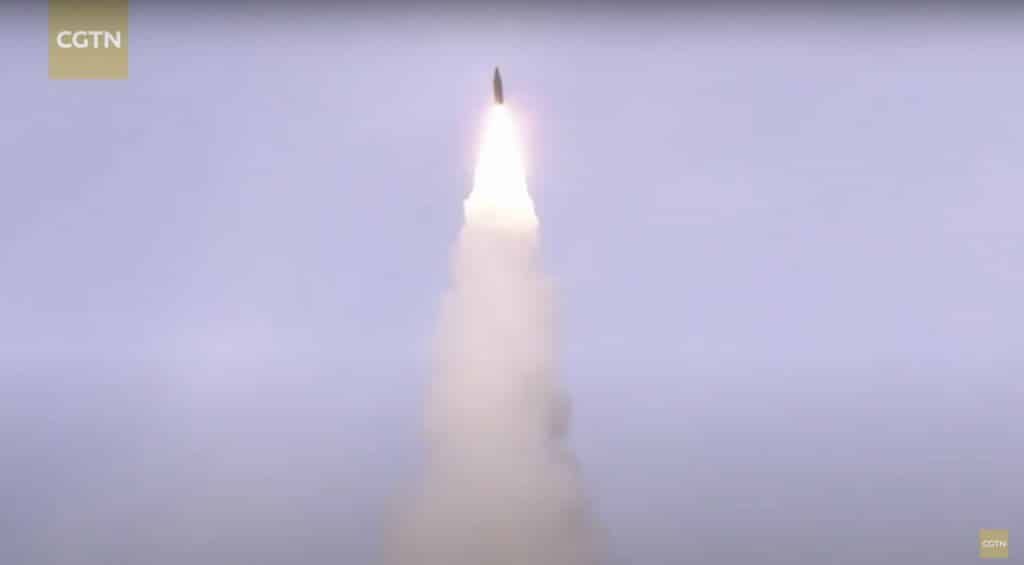Could China’s “hot-swappable” missile system start an accidental nuclear war?
By Sky Lo | April 8, 2022
 DF-26 intermediate-range ballistic missile fired during a 2019 combat drill, in a frame from a Chinese state media video. Credit: CGTN.
DF-26 intermediate-range ballistic missile fired during a 2019 combat drill, in a frame from a Chinese state media video. Credit: CGTN.
In the U.S.-China Economic and Security Review Commission’s most recent annual report to Congress, the commission suggested that the DF-26 Chinese missile system presents a unique escalatory threat in a potential conflict between China and the United States. The DF-26, which has a range of approximately 4,000 kilometers, is a dual-capable, “hot-swappable” system: The missile can carry either a conventional or a nuclear warhead, and warheads can be quickly swapped on launch-ready missiles. Ever since its public debut in 2015, the DF-26’s nuclear role has attracted significant attention from experts in the field. Some have suggested that using these missiles may lead to accidental nuclear escalation between China and the United States.
The worry is that the United States might see an incoming salvo of DF-26s and assume they are loaded with nuclear warheads. The American leadership might then decide to retaliate with nuclear weapons of its own, not knowing that the Chinese missiles are actually carrying conventional warheads. Other analysts have argued that pre-launch ambiguity may contribute to unintended escalation.
However, upon closer examination, nuclear escalation is not as likely as some believe.
The US response to incoming DF-26s. Modern early-warning systems are capable of calculating the trajectory and potential impact points for incoming warheads. In the case of a Chinese missile attack against US forces in the Indo-Pacific region, the United States would be able to identify incoming DF-26s as intermediate-range ballistic missiles heading toward US military bases located in the Pacific, rather than intercontinental ballistic missiles heading to the US homeland. Even if the Chinese missiles were loaded with nuclear warheads, these warheads would not hit major US population centers or reduce the effectiveness of US nuclear forces. US decision makers would not have much to lose by waiting until the missiles detonate before launching a counterattack. On the other hand, immediately launching a nuclear strike against China would likely result in a nuclear war that neither side wishes to fight.
The United States also has a very survivable sea-based deterrent and significantly more nuclear warheads than China. It would be nearly impossible for China to disarm the United States in a first strike. Even if American leaders were convinced that China was launching a nuclear strike against the United States, they would not have to immediately retaliate, as long as they were confident about US second-strike capabilities.
Also, assets that are especially vulnerable to a first strike could be evacuated and dispersed to avoid destruction. For example, the United States could immediately scramble strategic bombers carrying nuclear weapons, to avoid losing them on the ground. These measures can ensure that the United States does not have to launch an immediate retaliation even when under threat, reducing the possibility of an accidental nuclear war.
The Chinese response to a US attack. Some experts have suggested another type of scenario, in which the United States would fire conventional weapons at China’s DF-26 launchers in an attempt to neutralize a conventional attack on Guam. China might see such an attack as a direct threat to its nuclear deterrent. This could drive Chinese leaders to launch a nuclear retaliation under the “use it or lose it” mentality. Yet, upon closer examination, such an idea is flawed.
First, China is not reliant on the DF-26 weapon system for its nuclear deterrence. The intermediate-range DF-26 is arguably less important than intercontinental ballistic missiles (ICBMs), such as the DF-41, in maintaining a credible deterrent against the United States. This is reflected in the number of warheads deployed with each type of missile. While the exact number of nuclear warheads allocated to DF-26 units remains unknown, it is estimated that China has only deployed 60 out of some 350 total warheads with its intermediate-range force. It is therefore unlikely for China to worry about the credibility of its nuclear deterrent against the United States, as long as its ICBMs remain survivable and effective.
Furthermore, China’s nuclear warheads are deployed separately from its launch systems. The warheads are stored in underground bases and are only mated with their delivery systems in preparation for a strike. Warheads may also be dispersed and hidden within these large underground complexes to avoid destruction during a first strike.
A conventional strike against missile launch vehicles on the ground is unlikely to damage nuclear warheads stored underground. In the worst-case scenario, in which a small number of nuclear warheads are accidentally destroyed by the United States during a conventional strike, the Chinese nuclear deterrent would remain credible if it is able to inflict unacceptable losses on the United States in a nuclear exchange.
Finally, it is unlikely that the United States would accidentally hit Chinese ICBM launchers when trying to hit DF-26s. DF-26 brigades are separate from other types of Chinese missile brigades. ICBMs such as the DF-31 and DF-41 are also much larger than DF-26s. They do not share a common launch vehicle and can be identified more easily. Operationally, it is unlikely that China would intentionally disguise its ICBM launchers as intermediate-range missile launchers, knowing that the United States would likely target the latter in a conventional conflict.
In the worst-case scenario, in which the United States accidentally hits Chinese ICBM vehicles, it is unlikely that an accidental strike would be big enough to neutralize all Chinese second-strike assets immediately. China’s silo-based missiles and nuclear submarines would also survive. There would be no need for China to immediately launch a nuclear retaliation.
In short, DF-26s do not generate additional instability in the current deterrence relationship between China and the United States. Launching conventional attacks with or against these missiles is unlikely to result in accidental nuclear escalation. The dual-use nature of DF-26s is unlikely to significantly change the US strategic calculus when considering a conventional strike against these launchers.
The benefits of dual capability. Even if the DF-26’s ambiguity is unlikely to trigger a nuclear war, why would China develop a hot-swappable missile? What are the strategic benefits of using a dual-capable delivery system when China could just as easily develop two variants of the same missile?
Some analysts have suggested that China is deliberately trying to create ambiguity for its own sake. However, as established above, the escalatory risk of striking DF-26 launchers is relatively low, so the United States is unlikely to be deterred from attacking these launchers based on the risk of accidental nuclear escalation alone. The benefit of strategic ambiguity seems questionable at best.
A better answer may be cost. Instead of building dedicated nuclear-strike platforms (which are arguably less likely to be used), dual-use platforms allow China to expand both its conventional and nuclear capabilities with one system. The operational costs might also be reduced, because fewer personnel are required than for separate missile brigades. Furthermore, maintenance facilities for both the launch vehicle and the missiles can be shared to improve efficiency and reduce cost. This enables China to expand both its conventional and nuclear forces with a limited budget.
Apart from saving resources, dual-capable missiles are useful for maintaining secrecy and deceiving an adversary. China can hide the true number of its warheads with increased use of dual-use systems. As mentioned above, China’s nuclear warheads are mainly stored underground and are difficult to identify using satellite imagery. On the other hand, launch systems (such as silos) can be more easily identified. Thus, it is easier for analysts to estimate the size of Chinese nuclear stockpile by tracking the number of launch systems. However, with the deployment of dual-use launch systems, it becomes more difficult for analysts to estimate the Chinese nuclear stockpile accurately, because the ratio of launch systems to warheads is unknown. The difficulty in estimating China’s nuclear stockpile means that China can easily and diplomatically deflect any accusations about its nuclear build-up. It can also quietly expand its nuclear forces without drawing the attention of adversaries.
Finally, China may use these missiles as reserves for its main nuclear deterrent. As mentioned above, Chinese warheads are stored in underground tunnels away from the delivery systems. Thus, there is a chance for at least some of the warheads to survive a major nuclear exchange. On the other hand, in a hypothetical first strike against China, ICBMs are very likely to be targeted by enemy nuclear forces or launched in the subsequent retaliation. In a post-war environment, China could choose to install left-over warheads on unused DF-26s to quickly build a reconstituted deterrent. While these missiles do not have sufficient range to strike targets in the continental United States, they would be useful for regional deterrence against adversaries closer to China, such as India.
Regardless of the reasoning behind its development, the DF-26 represents a leap in Chinese precision strike capabilities. The increasingly robust Chinese nuclear force will be an important player in the deterrence relationships between nuclear powers for the foreseeable future.
Together, we make the world safer.
The Bulletin elevates expert voices above the noise. But as an independent nonprofit organization, our operations depend on the support of readers like you. Help us continue to deliver quality journalism that holds leaders accountable. Your support of our work at any level is important. In return, we promise our coverage will be understandable, influential, vigilant, solution-oriented, and fair-minded. Together we can make a difference.
Keywords: China, DF-26, dual-capable, missile
Topics: Nuclear Weapons, Opinion, Voices of Tomorrow















Do you think the analysis in the section headed ‘The US response to incoming DF-26s’ is apt for diagnosis of heightened risk of accidental nuclear war between China and India?